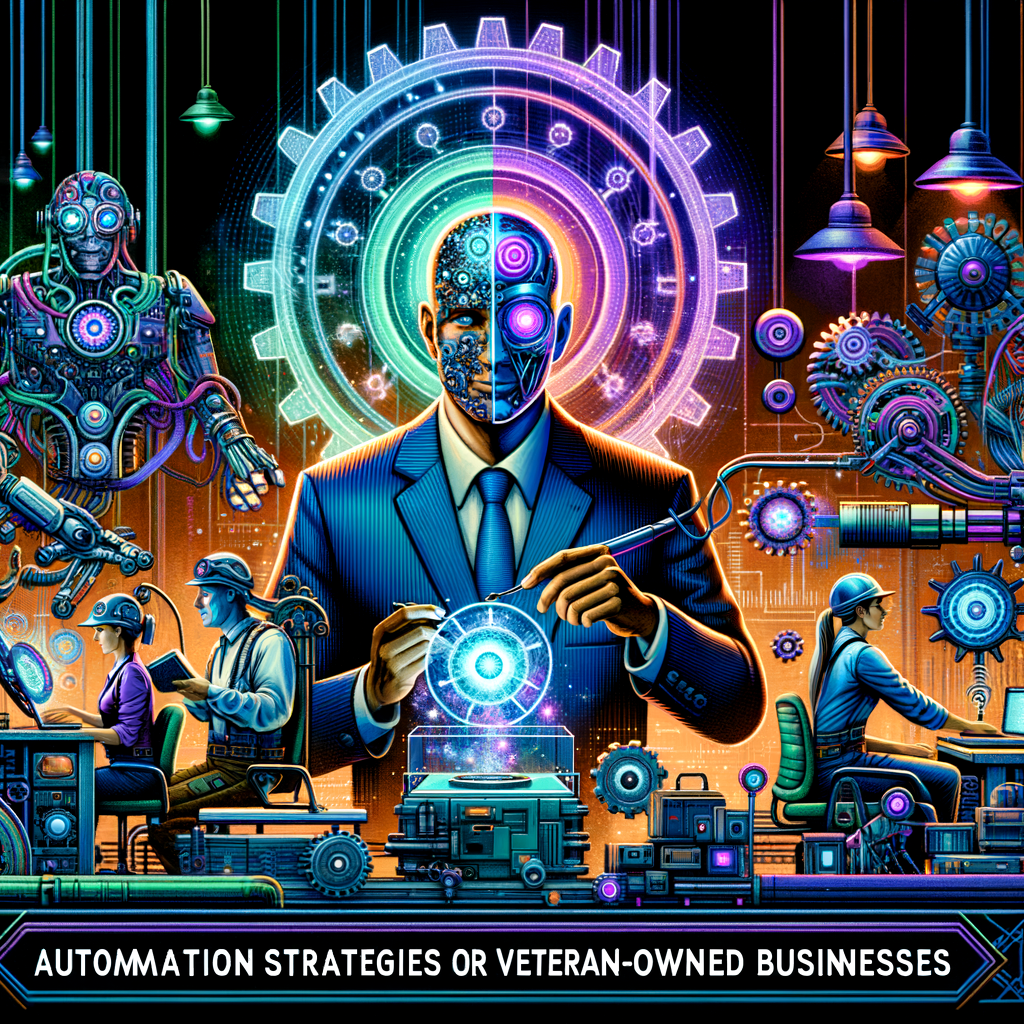Considering the extent to which technological advancements are revolutionizing how businesses operate, veteran-owned businesses stand to gain significantly by integrating automation into their operations.
Automation not only enhances efficiency but also allows these businesses to leverage their unique strengths and align with the dynamic market demands.
This article delves into the strategic implementation of automation in veteran-owned businesses, from assessing readiness to measuring impacts, and explores future trends that could shape the landscape of automated business processes.
Exploring Automation in Veteran-Owned Businesses
Automation in veteran-owned businesses can lead to substantial improvements in operational efficiency, customer service, and scalability.
Veterans, with their disciplined backgrounds, are well-suited to adopt structured technological systems that can automate repetitive tasks, streamline operations, and manage complex logistics.
By integrating automation, these businesses can focus on strategic growth areas, leveraging the precision and efficiency that automation technology offers.
Automation also opens doors to new business opportunities by improving data analysis capabilities and enabling more informed decision-making processes.
The primary areas where automation can be significantly beneficial include supply chain management, customer relationship management (CRM), and financial operations. Automated supply chain solutions can help veteran-owned businesses optimize inventory control, reduce costs, and enhance delivery efficiencies.
CRM tools can automate customer interactions, ensure timely follow-ups, and personalize customer experiences, leading to higher satisfaction and retention rates. In finance, automation can streamline invoicing, payroll processing, and compliance reporting, thereby reducing the risk of human error and enhancing financial accuracy.
Moreover, the use of automation in marketing processes can transform how veteran-owned businesses reach and interact with their target markets. Automated digital marketing tools can help in scheduling campaigns, segmenting audiences, and analyzing the effectiveness of different strategies, thus maximizing the impact of marketing efforts with minimal manual intervention. This integration of automation not only supports the operational backbone of these businesses but also empowers them to innovate and compete more effectively in their respective industries.
Assessing Your Business for Automation Readiness
Before diving into automation, it’s critical for veteran-owned businesses to evaluate their current processes and systems to determine readiness. This assessment should focus on identifying repetitive, time-consuming tasks that do not require human judgment, which are ideal candidates for automation. Additionally, businesses should evaluate their technological infrastructure to ensure it can support new automation tools, including necessary integrations with existing systems.
The readiness assessment should also include a skills analysis of the current workforce. Understanding the team’s ability to adapt to and work with automated systems will guide training and development needs. This ensures a smooth transition and optimal use of the automation tools. Moreover, leadership in veteran-owned businesses should foster a culture that embraces change and innovation, which is crucial for successful automation implementation.
Another aspect of readiness involves financial investment. Automation can require significant upfront costs, although the long-term savings and efficiency gains can be substantial. Businesses need to prepare financially for this transition, considering both the initial implementation and ongoing maintenance costs of automation systems. Having a clear financial framework in place will help mitigate risks associated with investing in automation technologies.
Choosing the Right Automation Tools and Platforms
Selecting the right automation tools and platforms is pivotal to achieving the desired outcomes. Veteran-owned businesses should focus on solutions that integrate seamlessly with their existing systems and that can scale as the business grows. Whether it’s cloud-based software for remote management or AI-driven analytics for enhanced decision-making, the chosen tools should align with the specific needs and goals of the business.
It’s advisable to seek tools that offer robust support and training options. Given that technology continuously evolves, having access to reliable customer service and ongoing training can help businesses adapt to and maximize new functionalities as they become available. Additionally, considering platforms with strong security measures is a must, as automation often involves handling sensitive data.
Collaboration between departments can also aid in selecting the right tools. Involving various teams in the decision-making process ensures that the chosen automation solutions are beneficial across different areas of the business. This holistic approach not only ensures a higher return on investment but also promotes widespread acceptance and utilization of the technology within the company.
Implementation Strategies for Smooth Transition
Implementing automation should be a strategic process that minimizes disruption while maximizing efficiency gains. Start with pilot projects that allow you to test automation on a small scale before a full rollout. This not only helps in identifying potential issues early but also provides a proof of concept that can help in fine-tuning the overall strategy.
Training and development are crucial during the implementation phase. Investing in comprehensive training sessions ensures that staff are comfortable and proficient with new technologies. Continuous learning opportunities should also be provided to keep pace with updates and changes in automation technologies.
Communication is key during implementation. Keeping all stakeholders informed about the changes, the benefits of automation, and the expected outcomes helps in managing expectations and fostering a culture of innovation. Regular feedback sessions can also be valuable, as they provide insights into how the automation tools are performing and how they can be improved.
Measuring the Impact of Automation on Efficiency
To truly understand the impact of automation, veteran-owned businesses need to measure changes in efficiency and productivity systematically. This might include tracking metrics such as time saved on tasks, error rates, and throughput rates before and after automation. Such data not only demonstrates the value of the investment but also highlights areas for further improvement.
Customer feedback can also serve as a crucial indicator of the success of automation. Enhanced customer satisfaction rates, increased retention, and positive customer reviews can all suggest that automation is having a positive impact on the business. Moreover, employee feedback is equally important, as it provides insight into how automation changes job roles and workflows, and how it affects staff morale.
Financial metrics should not be overlooked. An analysis of return on investment (ROI) from automation technologies can help in justifying current expenditures and guiding future investments in technology. Comparing operational costs before and after automation provides a clear picture of financial efficiency gains.
Future Trends: Staying Ahead with Automation
The future of automation in veteran-owned businesses looks promising, with emerging technologies such as AI, machine learning, and robotic process automation (RPA) becoming more accessible. These technologies can drive further efficiencies, enable better data-driven decisions, and create more personalized customer experiences. Staying updated with these trends and continuously assessing new technologies for applicability and impact can ensure veteran-owned businesses remain competitive.
Adoption of interoperable systems and platforms that can easily integrate with multiple technologies will be crucial. As businesses grow and their needs evolve, having flexible and adaptable automation systems will allow for seamless updates and additions without significant overhauls.
Lastly, fostering a culture of innovation and continuous improvement will play a vital role in remaining relevant in a rapidly changing business environment. Encouraging creativity and innovation within teams, and remaining open to novel solutions, will empower veteran-owned businesses to leverage automation technologies effectively and sustainably.
For veteran-owned businesses, automation presents an opportunity to capitalize on efficiency and innovation, driving growth and competitiveness in today’s digital economy. By carefully assessing readiness, choosing the right tools, implementing strategically, and continuously measuring impact, these businesses can maximize the benefits of automation. Looking ahead, staying abreast of technological advancements and fostering a forward-thinking culture are essential for leveraging the full potential of automation. With a disciplined approach to integration and adaptation, veteran-owned businesses can set a benchmark in operational excellence and strategic growth through automation.


